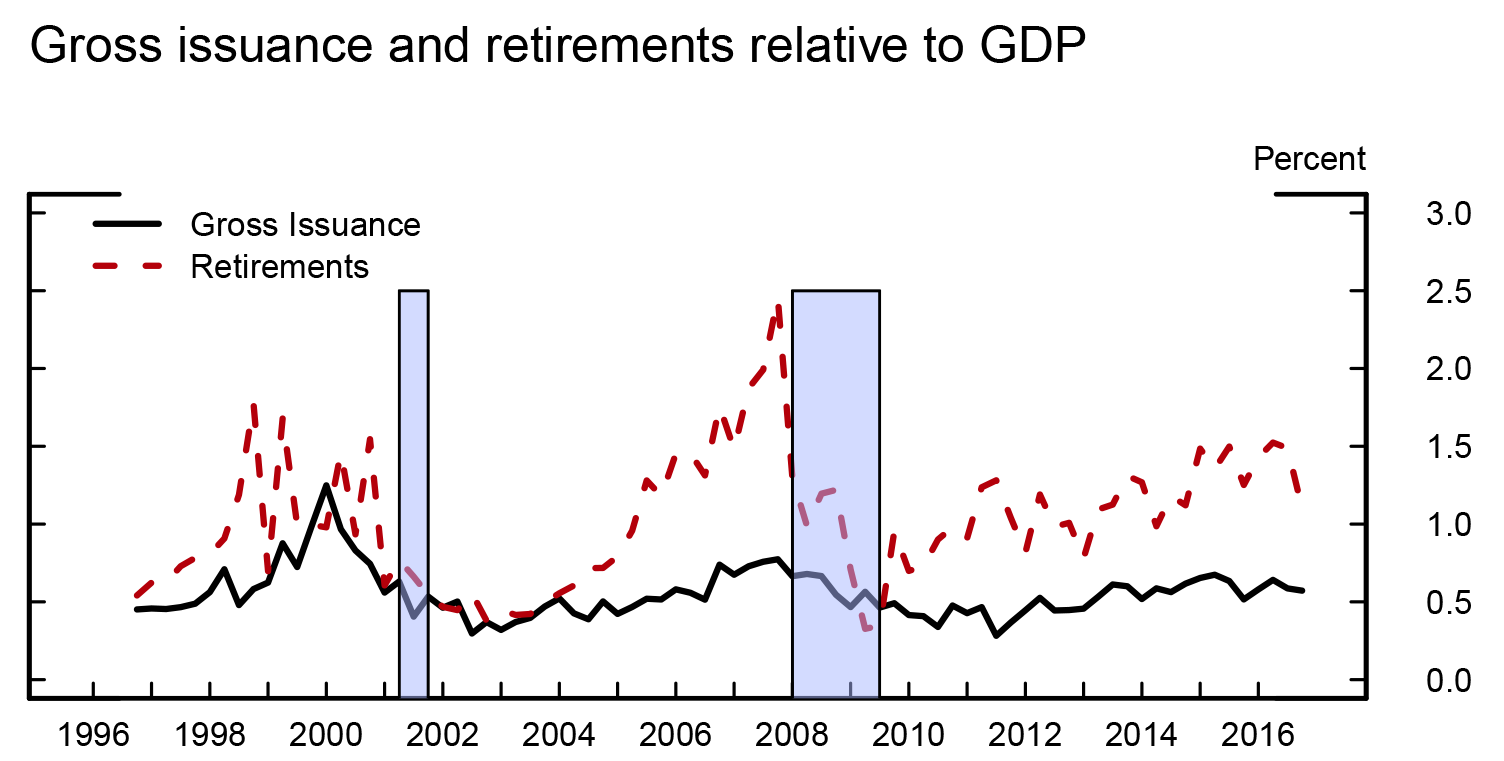FEDS Notes
June 16, 2017
Equity Issuance and Retirement by Nonfinancial Corporations
William R. Kuchinski, Richard E. Ogden, Damian R. Thomas, and Missaka Warusawitharana
The Financial Accounts of the United States reports quarterly net equity issuance of nonfinancial corporations.1 New Enhanced Financial Accounts (EFA) data provides additional information on gross equity issuance and equity retirements that underlie the net series, as well as monthly information on two components of gross equity issuance: initial public offerings (IPOs) and seasoned equity offerings (SEOs).2 As described below, these additional data help enhance our understanding of the use of equity finance by U.S. domiciled nonfinancial firms over the past couple of decades.
Definition
Net equity issuance in the Financial Accounts is constructed as the difference between gross equity issuance and equity retirements. Gross equity issuance equals the value of funds raised through the sale of equity by publicly and privately held nonfinancial firms. The IPO series measures funds raised by new public offerings of equity by firms that are trading publicly for the first time. The SEO series captures funds raised from new equity issuance by firms that are traded publicly at the time of issuance.
Equity retirements measures the value of nonfinancial firms' equity that is retired each quarter. The channels of retirement captured by this series comprise equity repurchases and retirements through mergers and acquisitions (M&A). Repurchases represent the value of equity repurchased by public nonfinancial firms through share buyback programs. Equity retirements through M&A activity measure the value of cash-financed transactions by domestic acquirers plus the value of both cash- and equity-financed transactions by foreign acquirers.3
Presentation in the Enhanced Financial Accounts
Expanded equity issuance and retirement data are available in the Enhanced Financial Accounts project released concurrently with this FEDS Note. Table 1 shows flow data for both gross issuance and retirements at quarterly and annual frequencies—net issuance is disaggregated into a gross issuance and a gross retirement measure, which is in turn broken down into retirements due to repurchases and those due to M&A activity. Additional detail for gross equity issuance is presented in Table 2, which shows the monthly IPO and SEO components of the overall gross issuance measure in Table 1. Historical data are available for download in CSV format beginning in 1996:Q4 for the quarterly data and January 1994 for the monthly data.
Data sources
Gross issuance includes equity issuance by public and privately held firms. Data on equity issuance by publicly listed corporations are obtained from S&P Capital IQ's North America Compustat database. We obtain firm-level data on funds raised through the sale of common and preferred stocks. Firms are designated as nonfinancial if their 4-digit Standard Industry Classification (SIC) code is below 6000 or at or above 7000. After limiting the sample to nonfinancial firms, we aggregate this series to measure the sale of equity by public corporations. We obtain data on equity transactions by privately held firms by aggregating information on venture capital financing, private equity investments, as well as private placements from a variety of sources.4
Data on equity repurchases are obtained from S&P Capital IQ's North America Compustat database, accessed through Research Insight. We include repurchases of both common and preferred stocks. The repurchase data are filtered to exclude foreign firms and subsidiaries. For firms with reporting quarter ends that do not align with the end of calendar quarters, we apportion the value of equity repurchased to the current and previous quarter based on whether the reporting period ends on the first or second month of the quarter. As in the case of gross equity issuance, firms are designated as nonfinancial based on their SIC codes.
Data on M&A activity are sourced from Thomson Reuters' SDC Platinum database. This comprises all U.S. domiciled targets (both public and private) from SDC's Mergers and Acquisition database, and includes transactions by both foreign and domestic acquirers.
Nonfinancial IPO and SEO issuance are obtained from Thomson Reuter's SDC Platinum software. Data on issuances of common and preferred stock are obtained from SDC Platinum's Global New Issues database. Additional filters on the data include ensuring that the ultimate issuing parent is a nonfinancial U.S. domiciled firm, and verifying that the security type is neither senior nor junior debt. Finally, transactions are categorized as IPOs or SEOs based on SDC's IPO flag code.
Equity financing over time

Shaded regions represent NBER recessionary periods (2001Q2 to 2001Q3 and 2008Q1 to 2009Q2, inclusive).
Figure 1 plots the quarterly gross issuance and retirement of equity as a ratio of GDP starting in 1996:Q4. The figure indicates that gross issuance scaled by GDP (the solid black line) has mostly fluctuated around a narrow band ranging from about 0.5% to 0.75% over this period, with the exception of the NASDAQ boom period in the late 1990s, when equity issuance was elevated. This suggests that, over the past twenty years, U.S. corporations have been raising funds by selling equity at a steady pace.
In comparison, equity retirements scaled by GDP (the dashed red line) exhibits a pronounced cyclicality. Equity retirement peaks just prior to the beginning of a recession. This is driven in part by the fact that the value of cash-financed mergers and acquisitions, which contribute importantly to equity retirements, increases with the value of the stock market, which is also strongly pro-cyclical.5 In addition, equity retirements through share repurchases are also pro-cyclical.
The figure also indicates that equity retirements have been consistently greater than issuances over this period, resulting in the negative values for net equity issuance reported in the Financial Accounts of the United States. This reflects the continued importance of share repurchases as a means of distributing earnings to shareholders, due in part to the tax advantage to shareholders of repurchases when compared to dividend payouts (see Brown et al., 2007). In addition, firms also use repurchases to offset the dilution of existing shareholders that occurs through the granting of equity to employees and executives, a common incentive compensation device.


Shaded regions represent NBER recessionary periods (2001Q2 to 2001Q3 and 2008Q1 to 2009Q2, inclusive).
The left and right panels of Figure 2, respectively, plot monthly IPO and SEO activity of nonfinancial firms as a ratio of the total stock market value from 1994 onwards. The left panel indicates that activity in the IPO market has steadily drifted downwards since its heyday in the late 1990s. Indeed, IPO activity has been quite lackluster over the current expansion. This may reflect, in part, the availability of ample equity financing for private firms through sources such as venture capital.
As shown in the right panel, SEO activity, while volatile, has not exhibited the secular decline seen in IPO markets. Furthermore, SEO activity is generally higher than IPO activity, helping explain the lack of a decline in gross issuance seen in Figure 1. One noteworthy fact is that SEO issuance rose notably as the recent financial crisis ended, possibly indicating an attempt by some publicly listed nonfinancial corporations to repair their balance sheets through equity finance.
Studies on equity financing
To highlight the importance and potential use of our new data, we conclude this note by mentioning a few studies that have examined the determinants and consequences of equity financing. One line of research studies the cyclicality of equity financing of nonfinancial firms. Covas and Den Haan, 2011, find that while equity issuance is procyclical for small firms, it is not so for large firms. Jermann and Quadrini, 2012, examine the cyclicality of equity financing flows through the lens of a model with financial frictions. And Eisfeldt and Muir, 2016, study the link between the cyclicality of external finance and firm savings.
Another strand of the literature uses the underlying micro-data to study IPOs, SEOs, and equity repurchases. Chen and Ritter, 2000, examine the fees associated with the underwriting of IPOs, while Ritter, 1991, documents the long-run underperformance of firms that carry out an IPO. DeAngelo et al., 2010, study how market-timing opportunities and the firm lifecycle stage influence SEO behavior. Grullon and Michaely, 2004, study why firms engage in share repurchases. Finally, Warusawitharana and Whited, 2016, investigate how equity misvaluation can influence the equity issuance and retirement behavior of firms. By releasing these additional details on the equity financing of nonfinancial corporations, we hope to stimulate further research into related topics.
References
Brown, Jeffrey R., Nellie Liang and Scott Weisbenner, 2007. Executive financial incentives and payout policy: Firm responses to the 2003 dividend tax cut, Journal of Finance, vol. 62, pages 1935-1965.
Chen, Hsuan-chi and Jay R. Ritter, 2000. The seven percent solution, Journal of Finance, vol. 55, pages 1105-1131.
Covas, Francisco and Wouter J. Den Haan, 2011. The cyclical behavior of debt and equity finance, American Economic Review, vol. 101, pages 877-899.
DeAngelo, Harry, Linda DeAngelo and Rene M. Stulz, 2010. Seasoned equity offerings, market timing, and the corporate lifecycle. Journal of Financial Economics, vol. 95, pages 275-295.
Eisfeldt, Andrea, J. and Tyler Muir, 2016. Aggregate external financing and savings waves, Journal of Monetary Economics, vol. 84, pages 116-133.
Gallin, Joshua and Paul A. Smith, 2014. Enhanced financial accounts, FEDS Notes 2014-08-1.
Grullon, Gustavo and Roni Michaely, 2004. The information content of share repurchase programs, Journal of Finance, vol. 59, pages 651-679.
Harford, Jarrod, 2005. What drives merger waves?, Journal of Financial Economics, vol. 27, pages 529-560.
Jermann, Urban and Vincenzo Quadrini, 2012. Macroeconomic effects of financial shocks, American Economic Review, vol. 102, pages 238-271.
Ritter, Jay R., 1991. The long-run performance of initial public offerings, Journal of Finance, vol. 46, pages 3-27.
Warusawitharana, Missaka and Toni M. Whited, 2016. Equity market misvaluation, financing, and investment, Review of Financial Studies, vol. 29, pages 603-654.
1. Line 2 of Table F.223, Corporate Equities (series mnemonic: FA103164103). Return to text
2. The EFA initiative is a long-term effort to augment the Financial Accounts of the United States with a more detailed picture of financial intermediation and interconnections, including supplementary information that offers finer detail, new types of activities, higher-frequency data, and more-disaggregated data (see Gallin and Smith, 2014). Return to text
3. For mergers and acquisitions by domestic firms that are financed by cash and stock, we consider only the cash portion for measuring equity retirement, as the retirement of the stock financed portion of the target's equity is offset by an issuance of stock by the acquirer of equal value. Return to text
4. Venture capital is sourced from The PwC/CB Insights MoneyTree™ Report, non-venture capital is sourced from Dow Jones Financial Services' Price Equity Analyst publication and the Wall Street Journal's Pro Private Equity publication, and private placements are sourced from Thomson Reuters' SDC Platinum database. Return to text
5. See Harford, 2005, for a discussion of the determinants of merger waves. Return to text
Kuchinski, William R., Richard E. Ogden, Damian R. Thomas, and Missaka Warusawitharana (2017). "Equity Issuance and Retirement by Nonfinancial Corporations," FEDS Notes. Washington: Board of Governors of the Federal Reserve System, June 16, 2017, https://doi.org/10.17016/2380-7172.2008.
Disclaimer: FEDS Notes are articles in which Board staff offer their own views and present analysis on a range of topics in economics and finance. These articles are shorter and less technically oriented than FEDS Working Papers and IFDP papers.